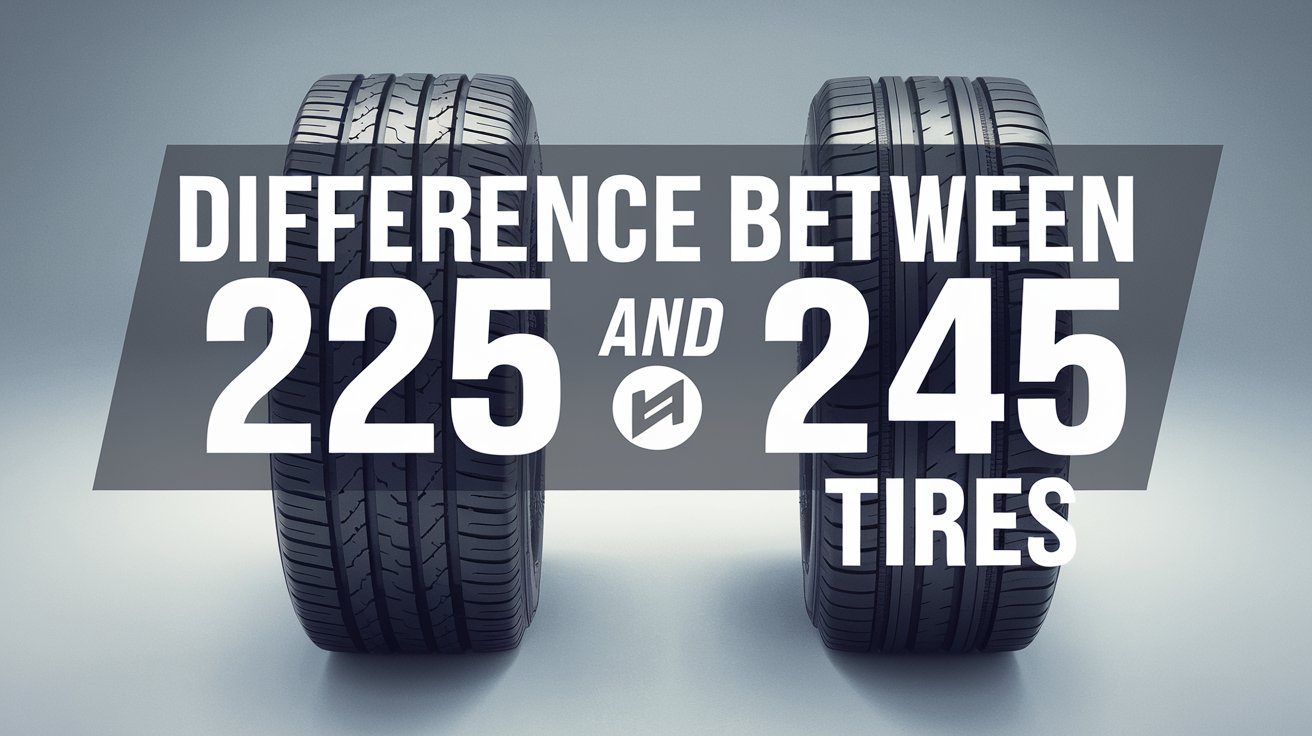 Date: August 28, 2024
Date: August 28, 2024
The appropriate tires for your car depend largely on its size. To ensure optimal vehicle performance, improved handling, and safe driving, tires play a crucial role. In most cases, the two common tire size options are 225 and 245. When it comes time to replace or update your tires, knowing the differences between these sizes is essential to making an informed choice.
Understanding Tire Sizes
Let’s start with some basic information about tire sizes before we get into the specifics of 225 and 245 tires. Tyres are often labelled with a combination of numbers and letters, such as P225/60R16. By using the code, the tire is divided into several parts, with each part indicating essential details.
P – It specifies that the tire is designed for use in passenger vehicles.
225 – The measurement of the tire’s width in millimeters.
60 – The aspect ratio represents the tire’s height-to-width ratio.
R – Signifies radial construction of the tire.
16 – Wheel diameter in inches.
Now let's delve into the differences between 225 and 245 tires.
Narrower and More Efficient 225 Tires.
The width of 225 tires is less than that of 245 tires. There are several advantages to the narrower width.
Fuel Efficiency: Smaller tires result in reduced rolling resistance, potentially enhancing fuel efficiency. Opting for 225 tires is a smart move to increase your gas mileage.
Snow and Ice Traction: 225 tires with narrower widths perform better in icy and snowy conditions. By enhancing traction and control, contribute to safer winter driving conditions.
Handling and Precision: Sports cars and agile vehicles often prefer narrower tires for better steering and handling.
It’s worth mentioning that 225 tires might have a slightly reduced contact area with the road, which could impact stability, particularly when making fast maneuvers.
Wider, grip-enhanced 245 tires
On the other hand, 245 tires are wider and offer their own advantages.
Enhanced Grip: The use of wider tyres enhances traction and stability due to the increased contact patch with the road. High-performance vehicles and off-road applications benefit greatly from this.
Cornering Stability: The increased width of 245 tires improves stability during cornering, making them a great choice for drivers who enjoy spirited driving or frequently navigate curvy roads.
Aesthetic Appeal: 245 tires are favored by many enthusiasts for their wider and more aggressive look, which can make your vehicle appear sportier.
Nonetheless, opting for wider tires can lead to reduced fuel efficiency due to increased rolling resistance and may not provide the same level of performance as narrower tires in snowy or icy conditions.
For better understanding, here's the high-level overview of the differences between 225 and 245 tires
| Feature | 225 Tires | 245 Tires |
| Tire Width | 225 millimeters | 245 millimeters |
| Handling & Performance | Adequate grip, better in wet conditions due to less hydroplaning risk | Improved grip and stability, especially in dry conditions |
| Fuel Efficiency | Generally more fuel-efficient due to lower rolling resistance | Slightly lower fuel efficiency due to higher rolling resistance |
| Comfort & Ride Quality | Smoother, more comfortable ride on uneven surfaces | Firmer ride, particularly on rough roads |
| Vehicle Compatibility | Commonly used on sedans, compact SUVs, and smaller vehicles | Often found on sports cars, larger sedans, and performance SUVs |
| Aesthetics | Balanced, streamlined appearance | More aggressive, sporty look |
| Cost | Typically less expensive due to narrower profile | Generally more expensive due to wider profile and performance benefits |
How to Choose the Right Size?
The decision of whether to go with 225 or 245 tires depends on what you prioritize in your driving experience. Take into account these factors when deciding.
- If you reside in a place where winters are harsh, 225 tires can be a safer option. 245 tires might be a better option in milder regions or for high-performance driving.
- How you drive makes a difference. If fuel economy and daily travel are your top priorities, going with 225 tires might be a better option.
- If you desire high performance and love driving with enthusiasm, 245 tires could be your ultimate option. Make sure the tire size you choose matches your vehicle’s specifications. For guidance, refer to the owner’s manual of your vehicle or consult a tire specialist.
Can you replace 235 tires with 245 tires?
While 235 and 245 tires are close in size, they are generally not interchangeable unless various factors are taken into account. Here’s the important information you should be aware of.
Wheel Compatibility: Start by verifying if your vehicle’s wheels can handle the larger 245 tires. The tire’s width should align with the wheel’s width or fall within the recommended range by the manufacturer. Putting a much wider tire (245) on a wheel made for a narrower one (235) can cause handling problems, shorter tire lifespan, and safety concerns.
Vehicle Fitment: It’s recommended to consult your vehicle’s manual or the manufacturer’s guidelines to determine the approved tire sizes for your specific make and model, even if your wheels can handle different sizes. The wheel well clearance can impact the compatibility of tires with certain vehicles.
Aspect Ratio: The aspect ratio, indicated by the middle number in the tire size (e.g., 235/60R16), should be taken into account. It indicates the height of the tires as a percentage of their width. To maintain the same tire diameter, the aspect ratio may need adjustment when switching from a width of 235 to 245. This ensures the accuracy of your speedometer and other vehicle systems.
Handling and Performance: In general, wider tires (245) provide better handling and grip compared to narrower tires (235). However, your car usage and driving preferences can also influence this. Ride comfort and fuel economy may be compromised in certain situations with wider tires.
Tire Availability: Make sure to confirm that the desired brand and model includes the required tire size (245) that you are seeking. Swift tire replacements rely on the availability of a diverse selection of spare tires.
The preference for either 245 or 225 tires will be determined by driving circumstances and personal choices. Take into account your priorities and consult with a tire specialist to determine the optimal option for your vehicle and driving preferences. Keep in mind that choosing the right tire size can greatly enhance your vehicle’s performance, safety, and overall driving experience.
